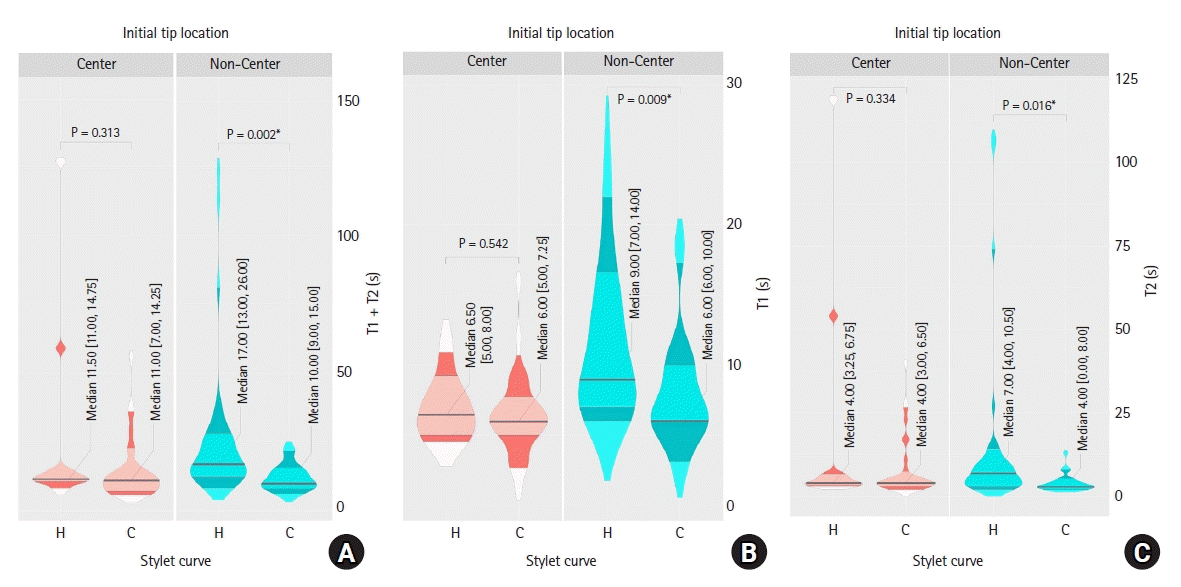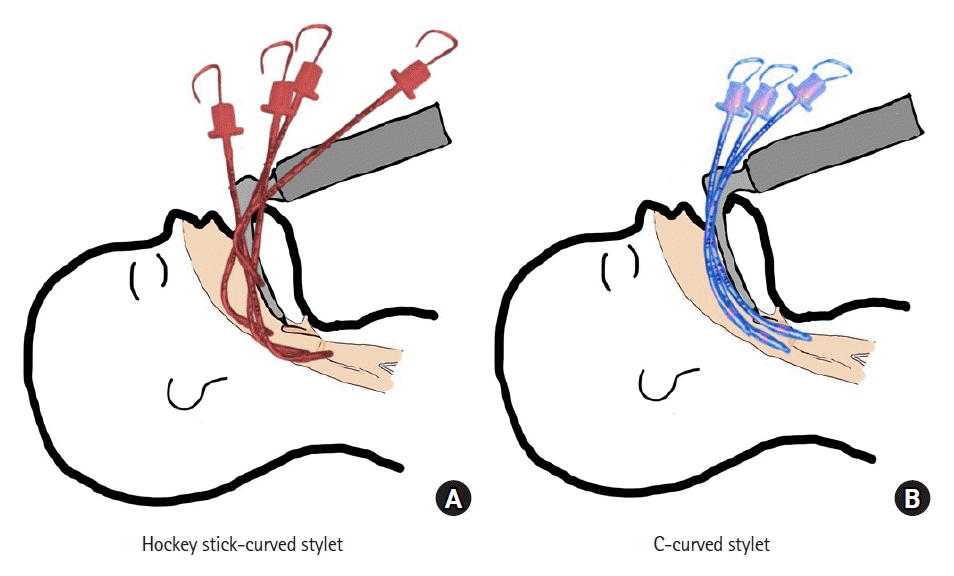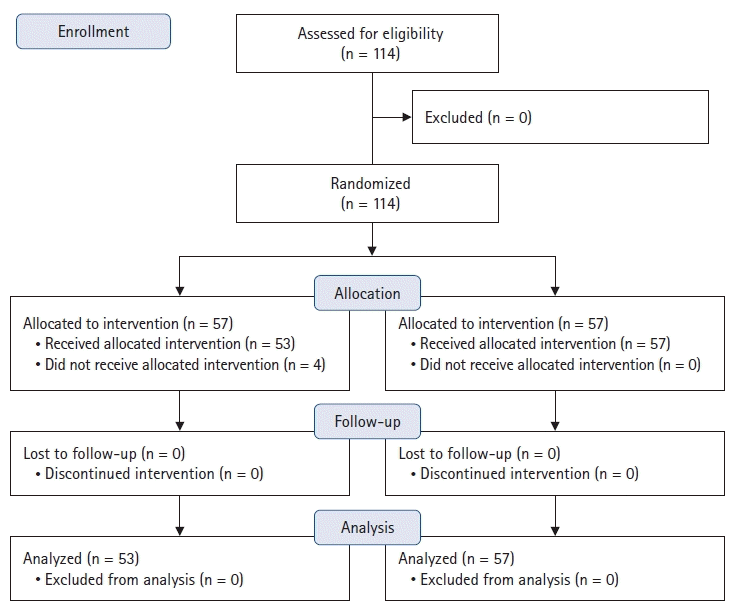1. Balaban O, Tobias JD. Videolaryngoscopy in neonates, infants, and children. Pediatr Crit Care Med. 2017; 18:477–85.

2. Kothari R, Hodgson KA, Davis PG, Thio M, Manley BJ, O’Currain E. Time to desaturation in preterm infants undergoing endotracheal intubation. Arch Dis Child Fetal Neonatal Ed. 2021; 106:603–7.

3. Vika Fatafehi Hala'ufia Lemoto, Sugimoto K, Kanazawa T, Matsusaki T, Morimatsu H. The incidence of desaturation during anesthesia in adult and pediatric patients: a retrospective study. Acta Med Okayama. 2018; 72:467–78.
4. Lee JH, Cho SA, Choe HW, Ji SH, Jang YE, Kim EH, et al. Effects of tip-manipulated stylet angle on intubation using the GlideScope® videolaryngoscope in children: a prospective randomized controlled trial. Paediatr Anaesth. 2021; 31:802–8.
5. Garcia-Marcinkiewicz AG, Kovatsis PG, Hunyady AI, Olomu PN, Zhang B, Sathyamoorthy M, et al. First-attempt success rate of video laryngoscopy in small infants (VISI): a multicentre, randomised controlled trial. Lancet. 2020; 396:1905–13.
6. Jain D, Mehta S, Gandhi K, Arora S, Parikh B, Abas M. Comparison of intubation conditions with CMAC Miller videolaryngoscope and conventional Miller laryngoscope in lateral position in infants: a prospective randomized trial. Paediatr Anaesth. 2018; 28:226–30.
7. Gupta A, Singh P, Gupta N, Kumar Malhotra R, Girdhar KK. Comparative efficacy of C-MAC® Miller videolaryngoscope versus McGrath® MAC size "1" videolaryngoscope in neonates and infants undergoing surgical procedures under general anesthesia: a prospective randomized controlled trial. Paediatr Anaesth. 2021; 31:1089–96.
8. Kelly FE, Cook TM. Seeing is believing: getting the best out of videolaryngoscopy. Br J Anaesth. 2016; 117 Suppl 1:i9–i13.

9. McElwain J, Malik MA, Harte BH, Flynn NH, Laffey JG. Determination of the optimal stylet strategy for the C-MAC videolaryngoscope. Anaesthesia. 2010; 65:369–78.

10. Salgo B, Schmitz A, Henze G, Stutz K, Dullenkopf A, Neff S, et al. Evaluation of a new recommendation for improved cuffed tracheal tube size selection in infants and small children. Acta Anaesthesiol Scand. 2006; 50:557–61.

11. Adnet F, Borron SW, Racine SX, Clemessy JL, Fournier JL, Plaisance P, et al. The intubation difficulty scale (IDS): proposal and evaluation of a new score characterizing the complexity of endotracheal intubation. Anesthesiology. 1997; 87:1290–7.
12. Min JJ, Oh EJ, Shin YH, Kwon E, Jeong JS. The usefulness of endotracheal tube twisting in facilitating tube delivery to glottis opening during GlideScope intubation in infants: randomized trial. Sci Rep. 2020; 10:4450.

13. Bang SR. Neonatal anesthesia: how we manage our most vulnerable patients. Korean J Anesthesiol. 2015; 68:434–41.

14. Prakash M, Johnny JC. Whats special in a child’s larynx? J Pharm Bioallied Sci. 2015; 7(Suppl 1):S55–8.

15. Raimann FJ, Cuca CE, Kern D, Zacharowski K, Rolle U, Meininger D, et al. Evaluation of the C-MAC miller video laryngoscope sizes 0 and 1 during tracheal intubation of infants less than 10 kg. Pediatr Emerg Care. 2020; 36:312–6.

16. Elattar H, Abdel-Rahman I, Ibrahim M, Kocz R, Raczka M, Kumar A, et al. A randomized trial of the glottic views with the classic miller, Wis-Hipple and C-MAC (videolaryngoscope and direct views) straight size 1 blades in young children. J Clin Anesth. 2020; 60:57–61.

17. Goel S, Choudhary R, Magoon R, Sharma R, Usha G, Kapoor PM, et al. A randomized comparative evaluation of C-MAC video-laryngoscope with Miller laryngoscope for neonatal endotracheal intubation. J Anaesthesiol Clin Pharmacol. 2022; 38:464–8.

18. Lane B, Finer N, Rich W. Duration of intubation attempts during neonatal resuscitation. J Pediatr. 2004; 145:67–70.

19. O’Donnell CP, Kamlin CO, Davis PG, Morley CJ. Endotracheal intubation attempts during neonatal resuscitation: success rates, duration, and adverse effects. Pediatrics. 2006; 117:e16–21.






 PDF
PDF Citation
Citation Print
Print





 XML Download
XML Download